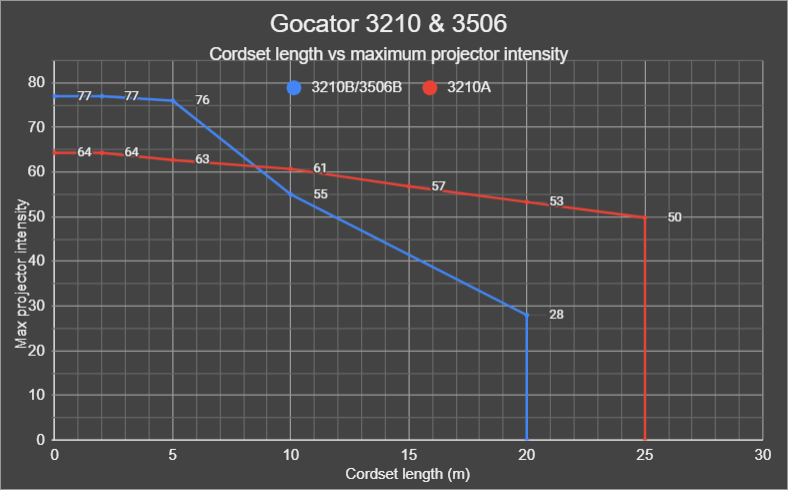Gocator 3210A or B, 3506B on 24 VDC
Gocator 3210 (A and B versions) and Gocator 3506 (A and B versions) can run at 24 VDC instead of the standard 48 VDC when required, for example due to regulations. However, with the exception of Gocator 3506A, lowering the operating voltage of these sensors to 24 VDC causes an increased current flow at constant power draw. The increased current will trip the sensor overcurrent protection at 1.1 amps, which will occur at maximum projector intensity, when the power draw is the highest. Note that longer cordsets introduce additional resistance, leading to increased current, again at constant power draw.
To operate at 24 VDC without tripping overcurrent protection, the sensor lowers the maximum projector intensity to limit the current flow. The following chart plots maximum projector intensity versus cordset length. Note that version B Gocator 3210 and 3506 sensors use a more powerful projector and therefore have different 24 VDC maximum intensity settings.

Note also that 3210B and 3506B have a maximum cordset length of 20 meters, whereas 3210A has a maximum of 25 meters. The 3506A is absent from the graph because its maximum power draw does not trip the sensor at 24 VDC.
When using 3210B or 3506B in A compatibility mode, the intensity values are similar to those of the A versions (although B versions are generally brighter), except for the maximum cordset length, which for B versions is limited to 20 meters instead of 25 meters.
You must consider the impact of the limitations of using 24 VDC on a case-by-case basis, but in general, applications will require longer exposure times. LMI recommends operating at 48 VDC if at all possible, or limiting cordset length. For longer exposure times, the sensor requires new exposure settings to accommodate for the different maximum projector intensity. For information on setting exposure, see the following sections.